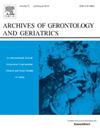一种新的组蛋白去乙酰化酶抑制剂通过调节NF-κB和Nrf2信号通路在OGD/R损伤中保护血脑屏障。
IF 3.5
3区 医学
Q2 GERIATRICS & GERONTOLOGY
引用次数: 0
摘要
缺血性中风是一种严重的脑血管疾病,在老年人中尤为普遍。研究表明,组蛋白去乙酰化酶(hdac)在缺血性脑卒中的发病机制中起着关键作用。我们介绍了一种新的hdac抑制剂HDI-1,作为这种疾病的潜在治疗策略。我们的研究表明,HDI-1可以加速缺氧-葡萄糖剥夺/再氧化(OGD/R)模型中紧密连接蛋白Occludin和Claudin-5的恢复。此外,HDI-1还能减轻损伤后细胞单层膜通透性的损害。这种效应可能源于HDI-1选择性抑制hdac - 2酶活性的能力。HDI-1通过抑制OGD/R损伤引发的NF-κB通路的激活,减少促炎细胞因子IL-1β、IL-6和TNF-α的分泌,从而减轻hCMEC/D3细胞的炎症反应。同时,HDI-1通过增强Nrf2/HO-1信号通路表现出抗氧化特性。总的来说,我们的研究结果表明HDI-1是缺血性卒中治疗的有希望的候选者。本文章由计算机程序翻译,如有差异,请以英文原文为准。

A novel histone deacetylase inhibitor protects the blood-brain barrier by regulating NF-κB and Nrf2 signaling pathways in OGD/R injury
Ischemic stroke, a severe cerebrovascular disease, is particularly prevalent among the elderly. Rsearch has indicated that histone deacetylases (HDACs) are pivotal in the pathogenesis of ischemic stroke. We introduce a novel HDACs inhibitor, HDI-1, as a potential therapeutic strategy for this condition. Our study reveals that HDI-1 expedites the restoration of tight junction proteins, Occludin and Claudin-5, in the oxygen-glucose deprivation/reoxygenation (OGD/R) model using human cerebral microvascular endothelial cells (hCMEC/D3). Moreover, HDI-1 mitigates the impairment of cellular monolayer membrane permeability following injury. This effect may stem from HDI-1′s ability to selectively suppress the enzymatic activity of HDAC2. By inhibiting the activation of the NF-κB pathway triggered by OGD/R injury, HDI-1 reduces the secretion of pro-inflammatory cytokines IL-1β, IL-6, and TNF-α, thereby diminishing the inflammatory response in hCMEC/D3 cells. Meanwhile, HDI-1 exhibits antioxidant properties by enhancing the Nrf2/HO-1 signaling pathway. Collectively, our findings propose HDI-1 as a promising candidate for ischemic stroke treatment.
求助全文
通过发布文献求助,成功后即可免费获取论文全文。
去求助
来源期刊
CiteScore
7.30
自引率
5.00%
发文量
198
审稿时长
16 days
期刊介绍:
Archives of Gerontology and Geriatrics provides a medium for the publication of papers from the fields of experimental gerontology and clinical and social geriatrics. The principal aim of the journal is to facilitate the exchange of information between specialists in these three fields of gerontological research. Experimental papers dealing with the basic mechanisms of aging at molecular, cellular, tissue or organ levels will be published.
Clinical papers will be accepted if they provide sufficiently new information or are of fundamental importance for the knowledge of human aging. Purely descriptive clinical papers will be accepted only if the results permit further interpretation. Papers dealing with anti-aging pharmacological preparations in humans are welcome. Papers on the social aspects of geriatrics will be accepted if they are of general interest regarding the epidemiology of aging and the efficiency and working methods of the social organizations for the health care of the elderly.

 求助内容:
求助内容: 应助结果提醒方式:
应助结果提醒方式:


